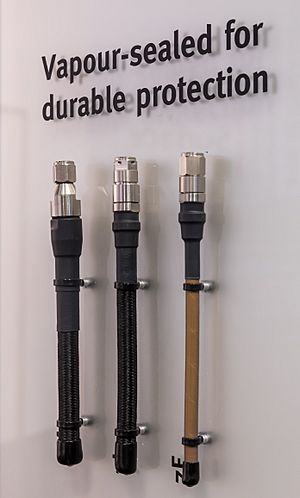- This page was last modified on 17 October 2025, at 10:18. Suggest an edit.
W. L. Gore & Associates facts for kids
 |
|
| Private | |
| Founded | 1958 |
| Founders | Bill Gore and Vieve Gore |
| Headquarters | Newark, Delaware, United States |
|
Key people
|
Bret Snyder, Chairman of the Board/President/CEO |
| Revenue | $3.168 billion (2017) |
|
Number of employees
|
10,500 (2019) |
W. L. Gore & Associates, Inc. is an American company that makes many different products from special plastics called fluoropolymers. It's a private company, which means its shares aren't traded on the stock market. Its main office is in Newark, Delaware. The company is most famous for creating Gore-Tex fabric, which is waterproof but also lets your skin breathe.
Contents
How Gore & Associates Started
The company began in 1958. It was founded by Wilbert (Bill) Lee Gore and his wife, Genevieve (Vieve) Walton Gore, in their home in Newark, Delaware. Bill Gore used to work for another big company called DuPont. There, he learned a lot about special plastics.
First Invention: Multi-Tet Cable
Bill Gore started his company in his basement. He wanted to find a way to cover electrical wires using a plastic called polytetrafluoroethylene (PTFE). This plastic was discovered by a chemist named Roy J. Plunkett at DuPont.
Bill's son, Robert W. Gore (Bob), was in college at the time. He suggested a way to cover the wires that worked really well! This led to the company's first patent, which is like an official right to an invention. Their first product was called Multi-Tet cable. It was a special cable with many wires inside, used in computers and communication systems.
Growing Beyond the Basement
By 1960, the company got a huge order for Multi-Tet cable. They needed to make a lot more! So, the Gores built a new factory in Delaware, which is still used today. By 1970, Gore had factories for wires and cables in places like Arizona, Scotland, Germany, and Japan.
The Discovery of Gore-Tex
Bob Gore joined the company in 1963 after finishing his studies in chemical engineering. In 1969, he was working with PTFE plastic. He was trying to stretch it into a tape for pipes. He tried many times, but it didn't work well.
A Surprising Stretch
One day, Bob tried something different. Instead of slowly stretching the heated plastic, he gave it a sudden, fast pull. To his surprise, the plastic stretched about 800% (8 times its original length)! This changed the solid PTFE into a material with tiny holes, like a sponge. It was about 70% air!
The company first called this new material "fibrillated PTFE." A year later, it was named "Gore-Tex expanded PTFE" (ePTFE). Today, most of Gore's products are made from this amazing ePTFE material.
Awards for Innovation
The Gore family and their inventions have won many awards:
- In 1985, Bill Gore received the Prince Philip Award (polymers) for his work in medical products. This award honors plastics that help people.
- In 2005, Bob Gore received the Perkin Medal for his important achievements in applied chemistry.
- In 2006, Bob Gore was added to the National Inventors Hall of Fame for inventing ePTFE.
Leadership and Growth
Bill Gore was the company's president until 1976, when Bob Gore took over. Bill remained chairman until he passed away in 1986. Genevieve Gore also stayed active with the company until she passed away in 2005.
Over the years, other leaders have guided the company, including Charles Carroll, Terri Kelly, Jason Field, and currently Bret Snyder. The company is still owned privately by the Gore family and its employees.
Gore & Associates is one of the largest private companies in the United States. It has almost 10,000 employees in over 50 locations around the world, including East Asia, Australia, Europe, and the Americas.
A Unique Company Culture
From 1984 to 2017, W. L. Gore & Associates was often named one of the "100 Best Companies to Work For" by Fortune magazine. Their European offices also received similar awards.
The "Lattice" Organization
A big reason for this recognition is Gore's special company culture. It's based on Bill Gore's idea of "task force teams" from his time at DuPont. These teams were small groups that worked together to solve problems.
In 1967, Bill Gore introduced the idea of a "lattice" organization to his employees, whom he called "associates." He later wrote down his ideas in a paper called "The Lattice Organization – A Philosophy of Enterprise."
Unlike traditional companies with bosses and strict rules, Gore has a flat, "lattice-like" structure. Everyone is called an "associate." There are no long chains of command. Instead of bosses, there are "leaders." Associates choose which leaders to follow. Employees are also reviewed by their teammates, not just a manager.
Four Important Principles
Bill Gore outlined four main principles for the company's culture:
- Freedom: Associates are free to help each other learn and grow.
- Fairness: Associates should treat everyone fairly.
- Commitment: Associates can make their own promises and are expected to keep them.
- Waterline: Before doing something that could really hurt the company's reputation or money, associates must talk to others. This is like not drilling a hole below a ship's "waterline" without checking first!
In this "lattice" way of working, associates talk directly to each other. They are responsible to their teams. The company encourages hands-on invention and trying out new ideas. Teams form around new opportunities or products. Leaders often naturally appear as people gain followers. This unique way of working helps employees be happy and stay with the company for a long time.
This special culture was even mentioned in books like The Tipping Point by Malcolm Gladwell and Reinventing Organizations by Frederic Laloux. Today, this kind of organization is sometimes called open allocation.
Gore's Amazing Products
Gore's products are all built around their main material: expanded PTFE (ePTFE) and other fluoroplastics. PTFE has many useful qualities that make it great for high-performance products:
- It's a good electrical insulator (doesn't let electricity pass easily).
- It can handle very hot and very cold temperatures (from -200°C to +260°C).
- It's very slippery (low coefficient of friction).
- It doesn't burn easily.
- It resists UV light from the sun.
- It repels water and oil (liquids don't stick to it).
- It doesn't react with most chemicals and is safe for use inside the body.
While PTFE is usually soft, Gore has found ways to make special forms of ePTFE that are much stronger and last longer. They can also add other materials, like chemicals that help reactions (catalysts) or things that stop germs. This allows them to create products with even more amazing uses, like membranes that let gases pass through but also react with chemicals.
Gore makes many different products from ePTFE, including tubes, fibers, tapes, membranes, and custom shapes like gaskets and patches. They test their products very carefully to make sure they work perfectly and are reliable.

